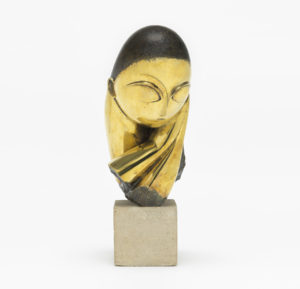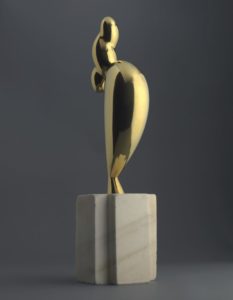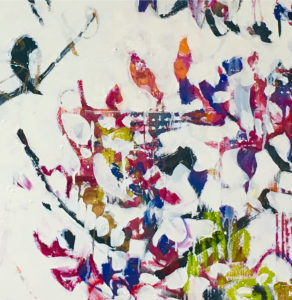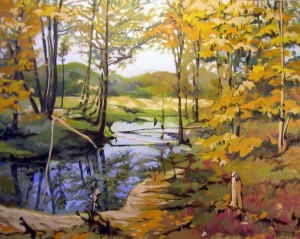Dear Artist,
Researchers at the University of Granada in Spain and the Washington University School of Medicine in St. Louis have published a study that says we weren’t always this creative. Creativity, they say, has been the deciding factor in our evolution into modern humans. The study identifies 972 “creativity” genes, which regulate three systems of learning and memory: emotional reactivity, self-control and self-awareness. The emotional reactivity network allows us to form social attachments and learn things. The self-control network gives us the ability to set goals, cooperate with others and make tools. The self-awareness network, unlike the other two, is unique to modern humans. Responsible for “episodic learning,” it allows us to remember experiences and improve upon past behaviors, as well as offering an autobiographical memory of our life, complete with a narrative with a past, present and future, “within which a person can explore alternative perspectives with intuitive insight and creative imagination.” It is this last item, say the researchers, that separates us from our distant primate relatives and earlier humans.

Mlle Pogany
version I, 1913 (after a marble of 1912)
Bronze with black patina 17 1/4 x 8 1/2 x 12 1/2 inches on limestone base
by Constantin Brâncuși (1876-1957)
While it’s intriguing to think that my self-awareness could be, rather than compulsiveness, say, what’s behind all this art-making, the study is a slap in the face to my feelings with regards to my late Airedale, Dorothy and her obvious interior life. Why else, for example, would Dorothy run, snow-angel-style, on the living room carpet, in her sleep, while yelping with delight? Or was it frustration? And what about all that acquired learning and improved climbing I witnessed through the studio window, at the base of a squirrel-infested Red cedar, and the artful arranging of sticks on the front lawn?
Senior author and professor emeritus of psychiatry and genetics at Washington University, Dr. Claude Robert Cloninger does not mention Airedales in his study. Instead, he maintains that Homo sapiens’ “self-awareness is what enables us to have divergent, original creative thinking [and to]be very flexible.” If he’s right, today’s paintings are the products of genes our distant relatives didn’t yet possess for their cave-painting sessions. Are our paintings, though, more creative? Perhaps painting is not solely dependent on creativity but rather reliant on a cocktail of all kinds of impulses. Perhaps painting is not even close to being the most creative artform. Perhaps, as a species, our creativity genes are responsible more for our Mars rovers, peacekeeping and life-saving vaccines than our brushwork. Rather than a signifier of progress, perhaps art is, among other things, a kind of emotional journalism — a record keeper of the human soul. Perhaps art, like air, has always been with us in some form, our creativity simply part of the evolving technology of an essential expression.

La jeune fille sophistiquée (Portrait de Nancy Cunard), 1932
Bronze on marble base
by Constantin Brâncuși
Sincerely,
Sara
PS: “What is art but life upon the larger scale, the higher. When, graduating up in a spiral line of still expanding and ascending gyres, it pushes toward the intense significance of all things, hungry for the infinite?” (Elizabeth Barrett Browning)
Esoterica: We have all been uniquely tasked with some kind of problem to solve — even Dorothy. Dr. Cloninger’s creativity genes are merely what gave us sapiens edge. The emotional reactivity network evolved in primates about 40 million years ago, the self-control network evolved about two million years ago, and the self-awareness and creativity network arrived a mere 100,000 years ago, right at the moment humans were grappling with a changing climate and a dwindling food supply. Sixty thousand years later, says Dr. Cloninger, Homo sapiens, with “unprecedented cultural and technological sophistication” began to rapidly replace Neanderthals across the globe. As lifespans increased, humans were able to accumulate more knowledge and experiences, build communities, migrate, gather and hold onto resources and make art. “What happened?” said Marina Abramovic. “Art happened.”
Have you considered a Premium Artist Listing? With each letter, an artist is featured at the bottom of this page. The Premium Artist Listings are a means of connecting artist subscribers through their work. Proceeds from each listing contribute to the production of The Painter’s Keys.
“There hasn’t been any art yet. Art is just beginning.” (Constantin Brancusi)
Featured Workshop
 Join Ellie Harold for “Intuitive Painting: Permission to Paint Expressively,” designed especially for mature women artists of all skill levels who wish to explore this medium for soulful exploration. The retreat provides attractive accommodations (your own room!) along with lightly structured activities for centering, relaxation and low stress art-making. You’ll have plenty of free time to muse, paint, write and reflect while enjoying the colors, textures and flavors of San Miguel. This Retreat has the potential to transform not only your art but your life! You’ll return home with a specific art “care plan” to assure support for further creating. Details at www.EllieHarold.com.
Join Ellie Harold for “Intuitive Painting: Permission to Paint Expressively,” designed especially for mature women artists of all skill levels who wish to explore this medium for soulful exploration. The retreat provides attractive accommodations (your own room!) along with lightly structured activities for centering, relaxation and low stress art-making. You’ll have plenty of free time to muse, paint, write and reflect while enjoying the colors, textures and flavors of San Miguel. This Retreat has the potential to transform not only your art but your life! You’ll return home with a specific art “care plan” to assure support for further creating. Details at www.EllieHarold.com.
Featured Artist
My statement is pretty short. I love all kinds of paintings and I think Robert Genn is Canada’s finest painter. A great feature of his work are his designs — so beautifully conceived.






17 Comments
Certainly a lot of food for thought here. Thank you . It’s one I will read more than once.
Blanca
Good post. I have to chuckle at the lasts part; ” the self-awareness and creativity network arrived a mere 100,000 years ago, right at the moment humans were grappling with a changing climate and a dwindling food supply.” Paul Stamets says ‘they migrated to find more food and came upon psilocybin mushrooms’ lol. Makes sense too, for creativity to kick in…
I enjoyed this letter Sara, and I guess I choose to be part of the “essential Expression” for us humans. Now as for my side kick Laika, an intelligent animal in my eyes, who never tires of finding new ways to get me to throw a stick for her, I must say has something to do with my own creativity, which I am thankful for. Yes art is with us and I believe it is both a record keeper and a catalyst.
Great post. One of the most fascinating books I have read on this subject was “Homo Aestheticus” by Ellen Dissanayake. As I understand it though, by the time the cave paintings of Lascaux were created Homo sapiens had achieved essentially the brainpower modern humans possess, which does explain the sensitivity and quality of their observation as recorded in their amazing representations of animals. The difference between the caliber of the animal renderings and the pictographic symbols indicates the ability to conceptualize and use symbols. While Homo Neanderthalis may not have reached this level I was taught in university biology to disabuse myself of my common prejudicial attitude that the Lascaux painters were less intelligent or evolved than myself. This is just one small point, however, in an excellent post. Plus, some researchers from the world of psychology and others from evolutionary biology or neuroscience may have differing views on these timelines.
Thank you for this post! Ellen’s book, Early Rock Art of the American West, is one of my go-to references in studying Petroglyphs here in the Southwest. And from other references, like Kelly says, Homo sapiens developed the essential brainpower of modern humans, a fact our Archaeology professors never let us forget. Your post, Sara, gives us another step in our evolution as human beings and perhaps a humble step at that.
The Lascaux painters probably were the well paid teachers of a hunting academy. Art for a reason, that could be understood.
Hungry for the infinite. What a statement.!! Perhaps painting isn’t even close to the most creative form. Another great statement. Over the past fifty years of my painting., I believe painting is as was written above…more of an emotional journalism. Im afraid we all take ourselves to seriously…I think I do. Thanks Sara.
Great letter, great comments! My reading list gets ever longer…not a complaint, but gratitude.
Aaaaaah, very interesting. I often wonder where I came from, the artist in me that is. Where did this creative obsession come from? .. am I unique and different from my genetic bloodline, or did I just end up finding painting as my time absorbing obsession. My mother would lose herself in sewing. My father in his garden, sometimes building things. I found in my mother in laws things one day a collection of hand made doilies carefully rolled up in a hand made fabric container. Gazing into the beauty of those intricate doilies I can see the hours it must have taken for her to crochet them. They were never acknowledges as beautiful art I am sure, just doilies that no one uses in decorating anymore. I think we all have artists inside us when we find one thing that satisfies that need to lose time creating something. I am glad, tho, that my great great grandchildren will have paintings to wonder what to do with, and not doilies that remain safely stored in a linen closet. :) Oh heck, I admit it, I put Grandma’s doilies out in various places, I love them.
This interesting read is reaffirmed in the recent book “Sapiens -!A Brief History of Mankind” by Yuval Noah Harari . His book challenges many of our thoughts about how we, as modern sapiens, became the dominant species on earth, even though other species were superior to humans before we evolved with a proportionally larger brain. But, that was not enough… it was our development of imagination that moved humankind forward by giving us, as the only animal on Earth with the ability to see the future a means to thrive in a threatening environment.
Without imagination our comparatively small, weak species never would have survived.
When I was very young (4 or so) I loved reading. I would fantasize that every book took down from the shelf would be replaced, like magic, with another. Then I started drawing. My parents could not afford paper, so I would draw in my books. Read, paint, paint read.!!!!!
Particularly interesting on this occasion. Martin Heidegger, whatever you think of his politics, was a great philosopher, and in his major work, “Being and Time” he discusses language and death in detailed analysis. His philosophy of language and its connection to Being is intimately connected with mortality. While it is a pretty complex and difficult philosophical work, Heidegger’s philosophy of language, (also in the sense of making signs filled with meaning as a communication from an artist to a reader of the sign, AKA a viewer,) clearly (on careful reading) links language and death in the sense of an expression of the experience of mortality and a drive to immortality. That is to say art is a response to the experience of mortality. Whether this is actually genetically embedded or socially transmitted, It clearly demands both self-awareness and sociality as a prerequisite. Both seem likely to enhance evolutionary fitness, within particularly the kinds of environments the human genus and those species assimilated or extinct have occupied over the last 2 million to 800,000 and maybe even down to the last 100,000 years. After all, genes or clusters of genes alone do not necessarily have a definitive function other than possibilities absent the external environmental factors which provoke their expression etc etc. What it takes to make art happen!
A fascinating article and one I particularly enjoyed reading. As a subscriber to The Painter’s Keys for a number of years now, it always stimulates my mind and creativity. Thank you also for the lovely Brancusi pictures – always a pleasure!
Heidigger also contributed a concept that, for me, was significant as an artist and engineer:
We understand things better when they break than when they are working.
Humans are weird. Most of them only speak one language. If they happen to speak three, as is not that uncommon in Europe and parts of the Middle East, they would still only speak approximately two-percent (2%) of the known languages on this planet. Painting, like some forms of Music, has the ability to overcome and perhaps even transcend the language barriers they might encounter. They are not, however, the only species on this planet that experiences dreams and has the capacity to express their imagination. A recent documentary showed an extended family of primates in a remote forest who take small, narrow branches and strip them of leaves and twigs and use the ‘rod’ to extract tasty, nutritious insects nesting beneath the bark of the tree the primates inhabit. Collectively. From there, it’s a relatively short hop in continuing evolution to cave-paintings in France to the telling of stories around a communal fire and the arrival of tribal rhythms. And song. To say that “The self-awareness network, unlike the other two, is unique to modern humans. Responsible for “episodic learning,” it allows us to remember experiences and improve upon past behaviors…” is both erroneous and misleading. The word ‘behavior’ does NOT take a plural. To say ‘behaviors’ suggests that humans display more than one pattern of behavior while certain primates do not. The capacity to learn is not confined to humans. Like the primates stripping branches to fashion a tool with which to feed themselves, humans do not have a monopoly on ambition. Yes, canines do have dreams. Thank you for the metaphor.
“What is art but life upon the larger scale, the higher. ‘ Elizabeth Barrett Browning gets it just right.
What we call art is ourselves being ourselves on a grander stage – expanding and enlarging ourselves wherever our individual talents allow. Children do it all the time. Then in many (most?) cases creativity somehow atrophies and is even actively discouraged by us so-called adults.
‘Shades of the prison house begin to close upon the growing boy’ as Wordsworth put it. Girls as well, it hardly needs saying.
Thanks for these quotes! Very apt!
Good commentary. Since I teach and have often asked to teach many genres. I have different styles for teaching ,and also particular shows, and I have my own personal direction which is abstract. At one juncture when a gallery owner which represented my work asked me if I would be willing to sign my abstracts with another part of my name and feature the two styles she liked of mine as two people. I thought about it a long while and decided my journey is about growth and if I had two styles to represent in her gallery, it should be signed by the same person. She disagreed. Confusing the collector may be a strong argument, but I feel I earned the disciplines by hard work and growth of experimentation toward understanding how art and style work intuitively together. My mentor said, “Each work should be done as an experiment to not set yourself on a particular outcome. Keep the surprise forever flowing in your work.”
The gallery and I did not part ways, but I do have her represent only the impressionistic side of my work. The two other galleries are fine with the duality of my work with one name. I often wondered if you or your father had an essay about this subject of two styles by one artist?